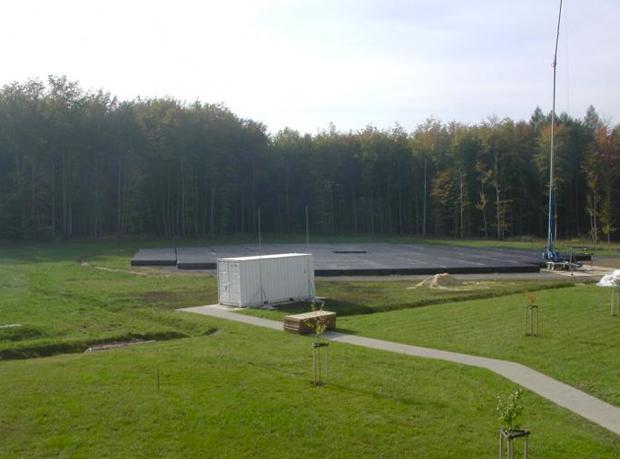Europeans Hope Their Low Frequency Array Will Complement US SETI
HBA Installation at the LOFAR site in Tautenburg – October 2009 (Photo: LOFAR)
A scientific quest for life elsewhere in the universe is facing some down-to-earth problems. The SETI Institute in California, considered the world’s premiere organization when it comes to scanning the skies for signs of extraterrestrial life, recently mothballed a powerful radio telescope it had been using to search for signals from alien civilizations. The effort has been put on hold due to a lack of money.
But the Americans aren’t the only ones involved in SETI, which stands for the Search for Extraterrestrial Life. Armed with a new kind of radio telescope, Europe’s Low Frequency Array, or LOFAR, hopes to complement the SETI work that was being done in the United States.
“SETI’s suffered a severe financial blow,” says Alan Penny, a British astronomer working with LOFAR.
Penny, who has spent much of his career searching for signs of life in the universe and who spent a year at the SETI Institute maintains that the field has not suffered, though, in terms of the science or the reason for doing the work. “And it’s certainly not suffered a severe blow in terms of the enthusiasm of the people, like me, who want to do it. It’s all part of the struggle,” says Penny.
LOFAR, which officially came online last year, is designed to study the early history of the universe. Whereas other radio telescopes look like giant satellite dishes, LOFAR consists of fields of antennas spread out over five European countries. And while many modern telescopes look for signals at higher frequencies, LOFAR aims at the lower, and noisier bands.
The same frequencies, in fact, where we send out radio and television transmissions.
“You’re trying to listen to a signal against a noisy background,” says Penny. “It’s as though you’re in a cocktail party and everyone is chattering, and you can’t hear what the person speaking to you is saying.”
Penny also likens it to the white noise you hear between radio stations.
“It’s a noisier part of the spectrum, but it’s also largely uncharted,” says Mike Garrett, director of ASTRON, the Netherlands Institute for Radio Astronomy, which is the driving force behind LOFAR.
Garrett says LOFAR’s unique design may help in broadening the search for alien signals. He is confident that the radio telescope can cut through the noise with the help of a supercomputer.
That said, he hopes the SETI Institute in California is able to get back on its telescopes soon. The work at LOFAR, he says, would be a great complement to it, since no one knows what part of the radio spectrum might hide signals from an alien civilization.
“It’s crucially important, I think, as a society and a global civilization to be be doing this kind of thing, and to be interested in this kind of thing,” Garrett says.
But the Low Frequency Array’s main task is not to look for extraterrestrial signals, and so Alan Penny will have to make the case to get his time for SETI work on LOFAR.
Penny admits that it is not always easy to convince governments or private donors that an alien signal is worth searching for.
“We don’t know if it’s there. We don’t know what it looks like. We don’t know if our way is the best way to find it. It’s quite a difficult sell,” Penny says. “The astronomers who have to make the hard decisions about should we fund this project, should we fund that project, have shied away from SETI.”
Penny’s currently crunching some data collected last year from LOFAR. He says its too soon to know if there are alien signals in the data. The first trick, he says, is to teach the system to weed out our own radio and TV transmissions. Then, if he gets the funding, he’ll get back on the telescope and back to the search.
Our coverage reaches millions each week, but only a small fraction of listeners contribute to sustain our program. We still need 224 more people to donate $100 or $10/monthly to unlock our $67,000 match. Will you help us get there today?
